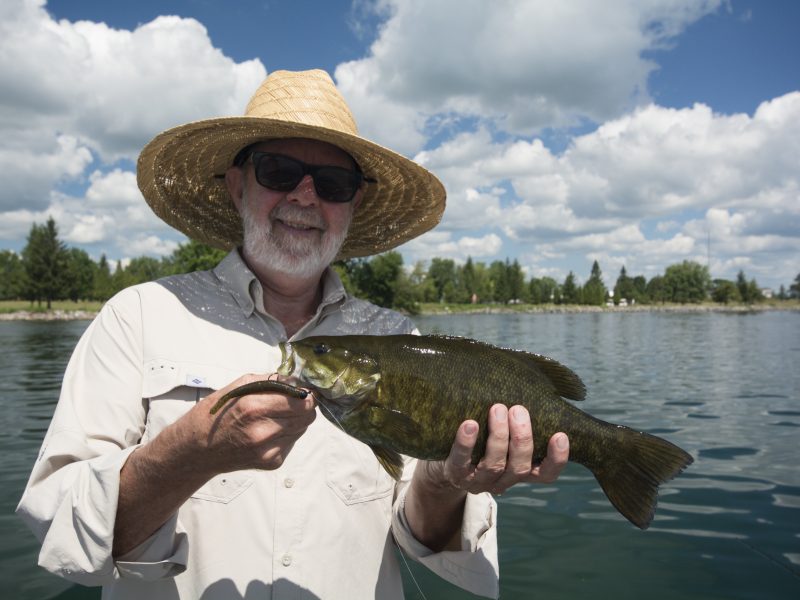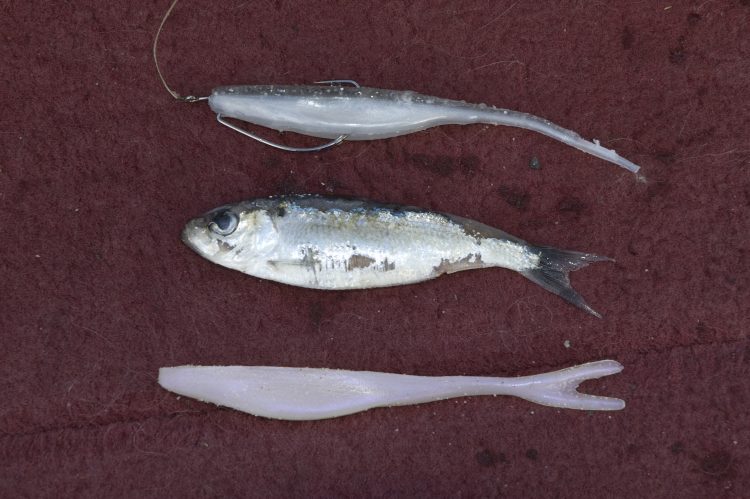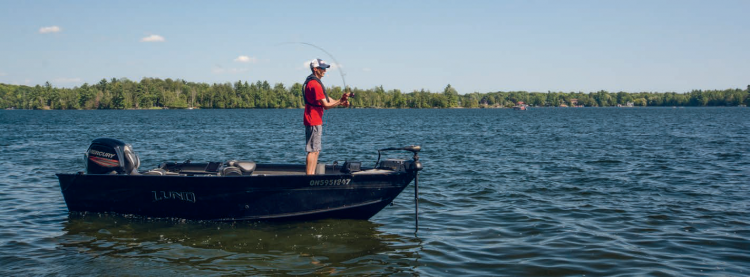Fishing with Glidebaits Pt. 2
Add a few varieties of glidebaits that move from side to side to increase your chances of hooking into bass.

Baits that slide, skate, and stride are often irresistible to bass. Tie one on and get a bite.
Finned Heavy Metal
Catching bass on jigging minnows remains popular. These “icefishing” baits sink fast and give off a solid return on sonar, making them perfect for video-gaming bass on deep structure. While their minnow profiles look the part, what really makes these baits the cat’s pajamas are their darting, gliding actions, which stems from their finned tails. The Rapala Jigging Rap is an original in this category. The Lunkerhunt Straight-Up Jig and Freedom Tackle Turnback Shad are also good options.
The Acme Hyper-Glide has a downward finned tail, like most jigging minnows, but features unique plastic side wings that open when the bait falls, causing additional drag, that slows and accentuates its gliding, swimming fall.
In addition to vertically fishing jigging minnows, snapping one behind the boat while moving forward with a trolling motor catches bass. The bait hops and darts off bottom, then glides downward. The more aggressive the jig stroke, the more erratic the action; the heavier the bait, the faster the fall, which triggers reaction strikes. I originally tried this tactic to search for walleye on sand and mudflats, but quickly learned that smallmouth bass absolutely clobber the presentation.
Soft Skaters
The soft-bait realm is full of gliders, though four- and five-inch jerk shads rank high on my list. Good soft jerkbaits include the Berkley PowerBait Jerk Shad, Lunker City Slug-Go, Strike King Z-Too, Z-Man Streakz, and Zoom Super Fluke.
These versatile baits catch bass in shallow cover that are holding on points and humps, and out in lake basins where pelagic bronze-backs prowl, to name a few scenarios.
On a twitching retrieve, the bait glides back and forth walk-the-dog style, but with additional subtle bends and quivers thanks to its pliable body and tapered, finesse tail. Depending on buoyancy, pausing may cause a bait to suspend, slowly rise, or slowly sink. Each move is potent, but the bass may prefer one over the others on a given day.

When faced with a tough bite, a cold-as molasses retrieve with a jerk shad is deadly. Give the bait a twitch, pause, then pause some more.
For the best horizontal gliding action, Texpose rig a jerk shad on a 3/0 or 4/0 offset, worm hook, though wide-gap hooks are a good idea for thicker plastics. A shank-weighted hook improves casting distance, increases running depth (depending on retrieve speed), and speeds up sink rate.
Nose-hooking with a 1/0 finesse hook is another option that gives the bait a slightly different action and possibly more downward glide, depending on the bait. Another benefit is that the hook is exposed so you can use lighter line while maintaining a good hookup ratio. I use Z-Man Streakz for this rigging because its durable Elaztech material holds the hook extremely well. For other plastics, add a screw-lock to the nose to anchor the hook in place.
Jigs and Plastics with Some Slide
The Berkley Fusion19 Snap Jig is a recent arrival and an interesting glider. It comes as light as 3/16 ounces and as heavy as 3/4 ounces. The Snap Jig’s belly fin is similar to a jigging minnow’s tail, which gives it a forward, darting swim and gliding falling action.
Since it’s a jig, anglers can experiment with different soft-bait profiles, colors, and scent infusions. A word of advice, though, is to stick with smaller, thin-tailed plastics like a Berkley Twitch Tail Minnow or forked-tail minnow. A plastic with a thick profile or wide, action-heavy tail may dampen the jig’s gliding action.
A 1/4-ounce Snap Jig rigged with a plastic minnow proved effective for me last summer. Fishing in 12 to 16 feet, I cast it beside deep milfoil, then let the jig fall to bottom. Next, a couple snaps of the rod got the jig dancing along the floor with an oh-so potent walk-the-dog sashay. I then paused and let it glide down. Largemouth and smallmouth slurped it up like candy.

A ball-head jig with a plastic minnow is another great gliding combination. In my experience, the critical detail here is using a plastic with a horizontal tail, such as a forked-tailed fluke, jerk shad, or dolphin-tailed minnow. Using as light a jig as possible maximizes the bait’s sliding action.
Small, 3-inch finesse baits and 1/16-ounce mushroom-shaped jigheads also seductively swoop through the water, catching bass with incredible efficiency. A swim-shake-glide retrieve with a Ned rig, tube, or another finesse plastic is hard for any bass not to eat.
The Ned rig’s popularity has spawned an array of new worm and creature finesse baits. Expect a bait with a wide bottom or flattened tail to have more of a gliding action when fished on a ball-, aspirin- or mushroom-shaped jig. Experiment with bait profiles to learn what bass prefer.

Going light isn’t just for finesse plastics, either. Texas-rigging a beaver-style bait and using a lightweight creates a sliding, gliding, meal-sized presentation thanks to the bait’s flat, wide body. It is very effective at coaxing strikes from largemouth. This rig works best beside docks, dunked in holes within weedbeds, and other zones where there is an opening in cover, though its lack of weight makes it ineffective at penetrating thick cover.
Try these gliding baits for bass and get ready for steady rod-bending action. When all else fails, you can always get ‘em on the glide.
Leave a Reply